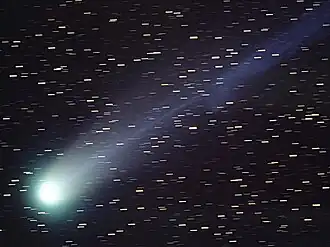C/1942 C1 (Whipple–Bernasconi–Kulin)
 Comet W–B–K photographed by George van Biesbroeck on 10 March 1942.[1] | |
| Discovery | |
|---|---|
| Discovered by |
|
| Discovery site | |
| Discovery date | 25 January 1942 10–13 February 1942 |
| Designations | |
| 1942 IV, 1942a[2] | |
| Orbital characteristics[3] | |
| Epoch | 29 March 1942 (JD 2430447.5) |
| Observation arc | 70 days |
| Earliest precovery date | 28 December 1941 |
| Number of observations | 8 |
| Perihelion | 1.445 AU |
| Eccentricity | 1.00102 |
| Inclination | 79.454° |
| 340.93° | |
| Argument of periapsis | 223.41° |
| Mean anomaly | –0.001° |
| Last perihelion | 30 April 1942 |
| Earth MOID | 0.622 AU |
| Jupiter MOID | 1.615 AU |
| Physical characteristics[4] | |
| Comet total magnitude (M1) | 4.4 |
| Comet nuclear magnitude (M2) | 8.6 |
| 5.92 (1942 apparition) | |
Comet Whipple–Bernasconi–Kulin, formally designated as C/1942 C1, is a non-periodic comet that was observed from December 1941 to January 1943. It was independently discovered by three astronomers, Fred Lawrence Whipple, Giovanni Bernasconi and György Kulin, respectively.
See also
References
- ^ G. van Biesbroeck (1942). "Comet Notes: Comet 1942a (Whipple)". Popular Astronomy. 50: 223–224. Bibcode:1942PA.....50..223.
- ^ "Comet Names and Designations". International Comet Quarterly. Retrieved 11 July 2025.
- ^ "C/1942 C1 (Whipple–Bernasconi–Kulin) – JPL Small-Body Database Lookup". ssd.jpl.nasa.gov. Jet Propulsion Laboratory. Retrieved 11 July 2025.
- ^ G. W. Kronk (2009). Cometography: A Catalog of Comets. Vol. 4: 1933–1959. Cambridge University Press. pp. 161–165. ISBN 978-0-521-58507-1.
External links
- C/1942 C1 at the JPL Small-Body Database

.png)